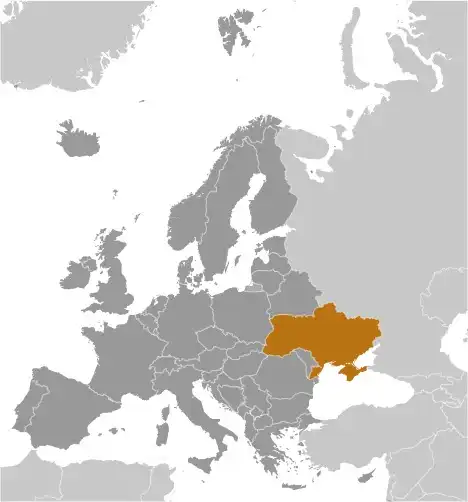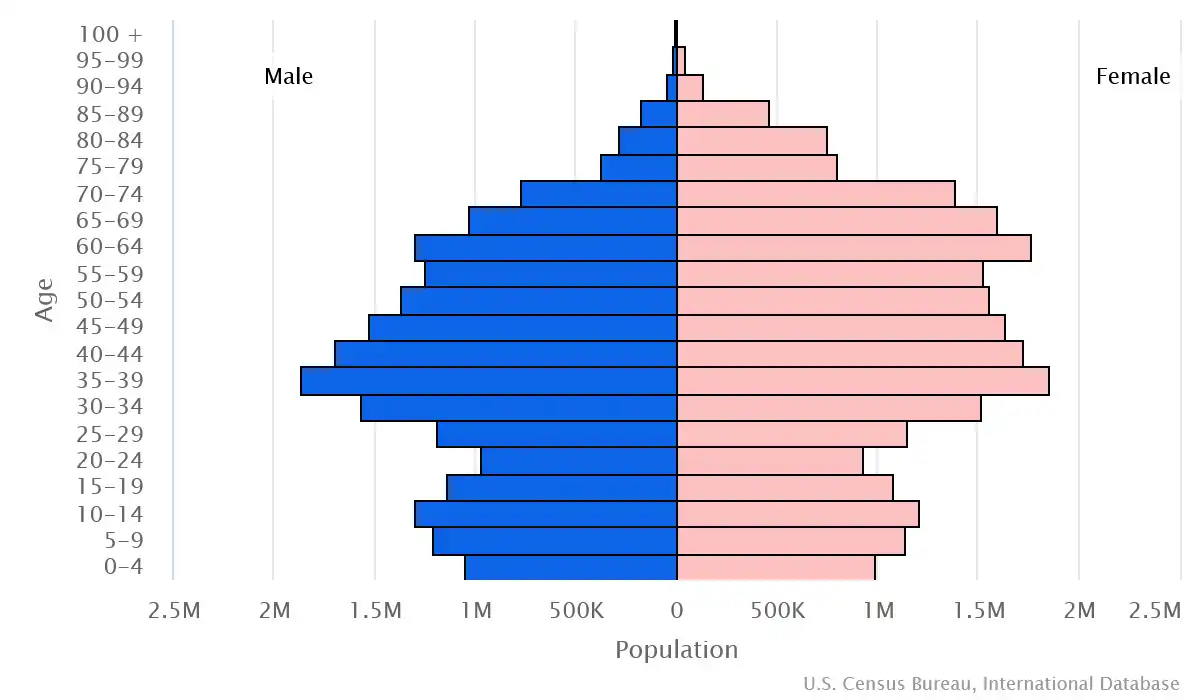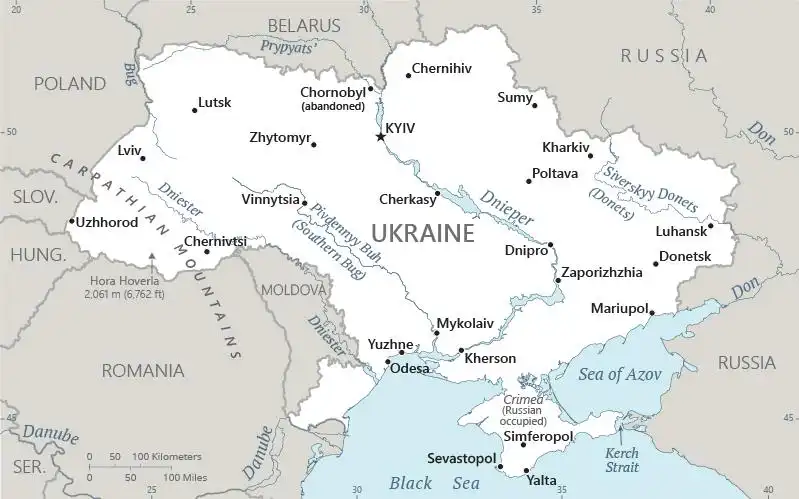
Ukraine
Country Data Dashboard

| Government type: | semi-presidential republic |
| Capital: | Kyiv (Kiev is the transliteration from Russian) |
| Languages: | Ukrainian (official) 67.5%, Russian (regional language) 29.6%, other (includes Crimean Tatar, Moldovan/Romanian, and Hungarian) 2.9% (2001 est.) |
People & Society
Ethnicity (2001 est.)
Religion (2013 est.)
Age structure

Economy
Economic overview
lower-middle-income, non-EU, Eastern European economy; key wheat and corn exporter; gradual recovery after 30% GDP contraction at start of war; damage to infrastructure and agriculture balanced by consumer and business resilience in western Ukraine; international aid has stabilized foreign exchange reserves, allowing managed currency float; continued progress on anti-corruption reforms
Real GDP (purchasing power parity) in Billion $
Real GDP per capita in $
Exports & Imports in billion $
Top 5 Import Partner in 2022 (48%)
Top 5 Import Commodities in 2022
- refined petroleum ⛽
- cars 🚗
- natural gas 💨
- garments 👕
- packaged medicine 💊
Top 5 Export Partner in 2022 (48%)
Top 5 Export Commodities in 2022
- corn 🌽
- seed oils 🛢️
- wheat 🌾
- iron ore ⛓️
- rapeseed 🌻
Geography
Map

Area
Natural resources
- iron ore ⛓️
- coal ⚫
- manganese 🪙
- natural gas 💨
- oil 🛢️
- salt 🧂
- sulfur 🧪
- graphite ✏️
- titanium 🪙
- magnesium 🔋
- kaolin 🪨
- nickel 🪙
- mercury ⚗️
- timber 🌲
- arable land 🌱
Climate
temperate continental; Mediterranean only on the southern Crimean coast; precipitation disproportionately distributed, highest in west and north, lesser in east and southeast; winters vary from cool along the Black Sea to cold farther inland; warm summers across the greater part of the country, hot in the south
Historical Background Information
Ukraine was the center of the first eastern Slavic state, Kyivan Rus, which was the largest and most powerful state in Europe during the 10th and 11th centuries. Weakened by internecine quarrels and Mongol invasions, Kyivan Rus was incorporated into the Grand Duchy of Lithuania and eventually into the Polish-Lithuanian Commonwealth. The cultural and religious legacy of Kyivan Rus laid the foundation for Ukrainian nationalism. A new Ukrainian state, the Cossack Hetmanate, was established during the mid-17th century after an uprising against the Poles. Despite continuous Muscovite pressure, the Hetmanate managed to remain autonomous for well over 100 years. During the latter part of the 18th century, the Russian Empire absorbed most Ukrainian territory. After czarist Russia collapsed in 1917, Ukraine -- which has long been known as the region's "bread basket" for its agricultural production -- achieved a short-lived period of independence (1917-20), but the country was reconquered and endured a Soviet rule that engineered two famines (1921-22 and 1932-33) in which over eight million died. In World War II, German and Soviet armies were responsible for seven to eight million more deaths. In 1986, a sudden power surge during a reactor-systems test at Ukraine's Chernobyl power station triggered the worst nuclear disaster in history, releasing massive amounts of radioactive material. Although Ukraine overwhelmingly voted for independence in 1991 as the Union of Soviet Socialist Republics (USSR) dissolved, democracy and prosperity remained elusive, with the legacy of state control, patronage politics, and endemic corruption stalling efforts at economic reform, privatization, and civil liberties.
In 2004 and 2005, a mass protest dubbed the "Orange Revolution" forced the authorities to overturn a presidential election and allow a new internationally monitored vote that swept into power a reformist slate under Viktor YUSHCHENKO. Rival Viktor YANUKOVYCH became prime minister in 2006 and was elected president in 2010. In 2012, Ukraine held legislative elections that Western observers widely criticized as corrupt. In 2013, YANUKOVYCH backtracked on a trade and cooperation agreement with the EU -- in favor of closer economic ties with Russia -- and then used force against protestors who supported the agreement, leading to a three-month protestor occupation of Kyiv's central square. The government's use of violence to break up the protest camp in 2014 led to multiple deaths, international condemnation, a failed political deal, and the president's abrupt departure for Russia. Pro-West President Petro POROSHENKO took office later that year; Volodymyr ZELENSKYY succeeded him in 2019.
Shortly after YANUKOVYCH's departure in 2014, Russian President Vladimir PUTIN ordered the invasion of Ukraine's Crimean Peninsula. In response, the UN passed a resolution confirming Ukraine's sovereignty and independence. In mid-2014, Russia began an armed conflict in two of Ukraine's eastern provinces. International efforts to end the conflict failed, and by 2022, more than 14,000 civilians were killed or wounded. On 24 February 2022, Russia escalated the conflict by invading the country on several fronts, in what has become the largest conventional military attack on a sovereign state in Europe since World War II. Russia made substantial gains in the early weeks of the invasion but underestimated Ukrainian resolve and combat capabilities. Despite Ukrainian resistance, Russia has laid claim to four Ukrainian oblasts -- Donetsk, Kherson, Luhansk, and Zaporizhzhia -- although none is fully under Russian control. The international community has not recognized the annexations. The invasion has also created Europe's largest refugee crisis since World War II, with over six million Ukrainian refugees recorded globally. It remains one of the two largest displacement crises worldwide (the other is the conflict in Syria). President ZELENSKYY has focused on boosting Ukrainian identity to unite the country behind the goals of ending the war through reclaiming territory and advancing Ukraine’s candidacy for EU membership.
